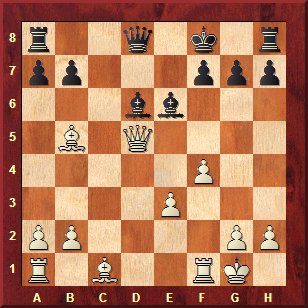| Rapid Chess Improvement: Evaluation of Positions |
 |
 |
 |
| Written by Yury Markushin |
| Monday, 08 February 2010 19:27 |
 What
exactly to do in order to improve my chess? It is a common question I
hear from different players all around, including my page on Facebook
and Twitter. What
exactly to do in order to improve my chess? It is a common question I
hear from different players all around, including my page on Facebook
and Twitter. I already gave an outline how to get better at chess, you may want to review it before reading further. In this article, I will suggest the list of things you need to take care of in order to quickly and effectively improve your game and gain elo points. I believe that very important aspect of the rapid chess improvement is properly organized training process. It can be divided into the following categories:
I will discuss Evaluation of Position in detail today, and save other categories for later time. Evaluation of Position What is evaluation of position? Basically it is a technique or an algorithm that let a chess player know what side is better in particular position on the board. It is a very important component of the game of chess. Based on that evaluation, chess player is making decisions for his next move or sequence of moves. It is well known fact that if you having a positional advantage you must attack, else you’re risking losing it. Needless to say, mistakes in evaluation of position can turn out to be deadly. Here is a quick example: if a player thinks that he will win that endgame after the rook exchange, but his evaluation of position isn’t correct, he will lose the endgame by exchanging the rooks. Why computers can play chess so well? They have precise algorithm of how the position changes with one or another move. Why GMs always beat amateurs? Because they can evaluate positions extremely well. Lesson? In order to play good chess you need to learn to evaluate chess positions precisely. Very common guideline for evaluating all chess positions consists of 4 categories:
King Safety – the difference of positions of the Kings. If one King is relatively safe in respect to the other one he gets a value from +1 to +2 points. We don’t take into account positions where a forced mate exists. Material on the board - standard numeric values for the pawns and pieces can be used here. So, Pawn = 1 point, Bishop = 3 point, Knight = 3 points, Rook = 5 points, Queen = 9 points, King is assigned to 3.5 points in the endgame. Pieces Activity - defined as the difference of activity between your piece and similar piece in the opponent’s camp (example Knight vs. Knight, Rook vs. Rook and Queen vs. Queen, etc.) Maximum difference in activity will be 1.5 points or 1.5 pawns. Pawn Structure – control of important squares (center) by pawns, weak pawns, strong pawns, isolated pawns past pawns can give maximum advantage of 2 points. Of course we don’t take into account extreme cases where pawn can checkmate or promote to a Queen. If White is better in particular position we will assign a positive value, such as +3, would correspond that White is 3 pawns up in position and material together. If Black is better we will write -3, which would mean Black is 3 pawns up. Take a look at the position below: 
White to move
Let’s evaluate the position above according to our 4 categories.
I recommend practicing this system on some random positions and applying this method to your own over the board (OTB) games. It is not necessary to apply this method after each move, in fact it would be very time consuming and impractical to do that. You need to do the deep evaluation only in critical positions, such as after the end of an opening theory or a critical position when it is hard to see what to play. It is a very good method to apply if you don’t know what to do in positional game. It will guide you through the game, show what pieces to exchange (your inactive pieces for active pieces of your opponent). |





No comments:
Post a Comment